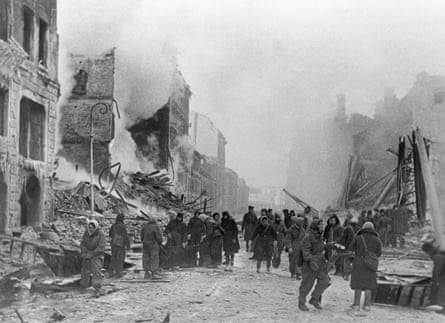Description

Disclaimer: Copyright infringement not intended.
Context
- Vladimir Putin's comparison of Israel's actions in Gaza to the Nazi siege of Leningrad is a highly charged statement, drawing on the historical significance of the siege and the personal connection Putin has to the event.
Details
- Magnitude of Tragedy:
- The comparison highlights the massive scale of the tragedy during the siege of Leningrad, where over 1.5 million people lost their lives, many of whom were civilians.
- It emphasizes the horrific consequences of siege warfare, particularly the deliberate starvation and destruction of civilian populations.
- Use of Starvation as a Weapon:
- The comparison suggests that like the Nazis during the siege of Leningrad, Israel's actions in Gaza might be viewed as employing similar tactics of systematic deprivation to weaken the population and apply pressure.
- Putin's reference to "systematic starvation" in Leningrad underscores the severity of the humanitarian crisis and the intentional targeting of civilians through deprivation.
- Political Significance:
- Putin's comparison could be viewed as a condemnation of Israel's military actions and policies in Gaza, serving to underscore the gravity of the situation and draw attention to the humanitarian crisis in the region.
- By invoking such a powerful historical event, he aims to evoke a strong emotional response and draw global attention to the plight of the people in Gaza.
- Potential Controversy:
- The comparison has the potential to spark controversy and debate, as the events in Gaza and the siege of Leningrad are distinct in their historical, political, and social contexts.
- Critics might argue that the situations are not directly comparable and that such comparisons risk minimizing the unique historical context of the siege of Leningrad.

About
- The Nazi siege of Leningrad, now known as Saint Petersburg, which occurred during World War II, is one of the most devastating and prolonged sieges in history.
- Lasting from September 1941 to January 1944, it resulted in the deaths of hundreds of thousands of civilians due to starvation, disease, and shelling.
Background:
- Operation Barbarossa: On June 22, 1941, Nazi Germany initiated Operation Barbarossa, the invasion of the Soviet Union. One of the primary objectives was the capture of Leningrad, a vital industrial and cultural center in the USSR.
- Leningrad's strategic importance: Leningrad was crucial to the Soviet Union's war effort, as it was a key industrial city and the main port on the Baltic Sea.
Siege and Blockade:
- Initial stages: The German Army Group North, under the command of Field Marshal Wilhelm Ritter von Leeb, surrounded Leningrad by September 8, 1941, effectively cutting off all supply routes to the city.
- Blockade: The German army, along with Finnish and Spanish troops, cut off all supply lines, leaving the city's inhabitants without adequate food, fuel, or medical supplies.
Humanitarian Crisis:
- Starvation and disease: The population of Leningrad faced extreme food shortages, leading to a severe famine. The harsh winter and lack of resources resulted in widespread starvation and malnutrition. Diseases, such as typhus, also claimed many lives.
- The Road of Life: A crucial lifeline for the city was the "Road of Life," a path across the frozen Lake Ladoga that allowed supplies to reach Leningrad during the winter months.
Resistance and Resilience:
- The Leningrad Front: Despite the dire circumstances, the Red Army's Leningrad Front continued to resist the German forces. They launched counteroffensives and maintained the city's defense.
- Cultural resilience: Leningrad's cultural figures, including artists, writers, and musicians, continued to create and perform, offering a symbol of resilience and defiance against the Nazi siege.
Liberation and Aftermath:
- Soviet offensive: The siege was lifted on January 27, 1944, when the Soviet forces managed to break through the German lines, effectively ending the blockade.
- Human cost: The siege resulted in the deaths of approximately 1.1 million civilians and military personnel. Leningrad's infrastructure and cultural landmarks were severely damaged during the conflict.
- Legacy: The siege of Leningrad remains a symbol of the enduring human spirit in the face of extreme hardship. It is commemorated as a significant event in Russia's history, serving as a reminder of the sacrifices made during World War II.
Commemoration:
- Piskaryovskoye Memorial Cemetery: The Piskaryovskoye Memorial Cemetery in Leningrad serves as a tribute to the victims of the siege, with rows of mass graves commemorating the civilians who perished during the blockade.
- Siege of Leningrad Museum: The Siege of Leningrad Museum, located in the city, exhibits artifacts, photographs, and personal accounts, preserving the memory of the siege for future generations.

Conclusion
The siege of Leningrad stands as a tragic testament to the brutality of war and the resilience of the human spirit in the face of unimaginable suffering and hardship.
|
PRACTICE QUESTION
Q. Examine the significance of the Nazi siege of Leningrad during World War II. Discuss its impact on the course of the war, the civilian population, and the subsequent historical memory. Also, analyze the role of resilience and cultural resistance in the context of the siege. (250 Words)
|







